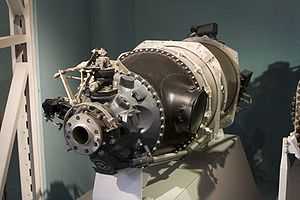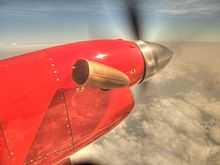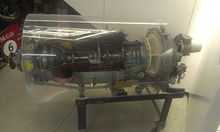Pratt & Whitney Canada PT6
| PT6 | |
|---|---|
 | |
| A PT6A-20 on display at the Canada Aviation and Space Museum | |
| Type | Turboprop / turboshaft |
| National origin | Canada |
| Manufacturer | Pratt & Whitney Canada |
| First run | 1960[1] |
| Major applications | Beechcraft Super King Air de Havilland Canada DHC-6 Twin Otter Pilatus PC-12 Sikorsky S-76 |
| Variants | Pratt & Whitney Canada PT6T |
The Pratt & Whitney Canada PT6 is one of the most popular turboprop aircraft engines in history,[2] and is produced by Pratt & Whitney Canada. The PT6 family is particularly well known for its extremely high reliability, with MTBOs on the order of 9000 hours in some models.[3] In US military use, they are designated as T74 or T101. The main variant, the PT6A, is available in a wide variety of models, covering the power range between 580 and 920 shaft horsepower in the original series, and up to 1,940 shp (1,450 kW) in the "large" lines. The PT6B and PT6C are turboshaft variants for helicopters.
Design and development
In 1956, PWC's President, Ronald Riley, foreseeing the need for engines with much higher power to weight ratios, ordered engineering manager Dick Guthrie to establish a development group to create a turboprop engine designed to replace piston engines. Demand for the Pratt & Whitney Wasp radial engine was still strong and its production line's output was robust and profitable. Riley gave Guthrie a modest budget of 100,000 Canadian dollars. Guthrie recruited young engineers from the National Research Council in Ottawa and from Orenda Engines in Ontario. In 1958, the group began development of a turboprop engine intended to deliver 450 shaft horsepower. The first engine was powered up and run successfully in February 1960.[1][4] It first flew on 30 May 1961, mounted on a Beech 18 aircraft at de Havilland Canada's Downsview, Ontario facility. Full-scale production started in 1963, entering service the next year. By the 40th anniversary of its maiden flight in 2001, over 36,000 PT6As had been delivered, not including the other versions.[5] The engine is used in over 100 different applications.
Design innovations included keeping the power turbine and propeller shaft sections independent, connecting them with a fluid coupling analogous to an automotive torque converter.[6] The igniter starts only the gas generator, making the engine easy to start, particularly in cold weather.[6] The engine consists of two sections that can be easily separated for maintenance.[6] In the gas-generator section air enters through an inlet screen into the low-pressure axial compressor. This has three stages on small and medium versions of the engine and four stages on large versions. The air then flows into a single-stage centrifugal compressor, through the annular reverse-flow combustion chamber, and finally through a single-stage compressor turbine that powers the compressors at about 45,000 rpm. The hot gas from the gas generator section then flows into a separate power section of the engine, containing a single-stage power turbine driving the power take-off system at about 30,000 rpm. For turboprop use, this powers a two-stage planetary output reduction gearbox, which turns the propeller at a speed of 1,900 to 2,200 rpm. The exhaust gas then escapes through two side mounted ducts in the power turbine housing. The engine is arranged such that the power turbines are mounted inside the combustion chamber, reducing overall length.

In most aircraft installations the PT6 is mounted backwards in the nacelle, so that the intake side of the engine is facing the rear of the aircraft. This places the power section at the front of the nacelle, where it can drive the propeller directly without the need for a long shaft. Intake air is usually fed to the engine via an underside mounted duct, and the two exhaust outlets are directed rearward. This arrangement also aids maintenance by allowing the entire power section to be removed along with the propeller, exposing the gas-generator section. It also allows rough-field operations with foreign objects slung outside and around the turbine intake by internal separators in the inlet.[7]
Several other versions of the PT6 have appeared over time. The PT6A large added an additional power turbine stage and a deeper output reduction, producing almost twice the power output, between 1,090 and 1,920 shp (1,430 kW). The PT6B is a helicopter turboshaft model, featuring an offset reduction gearbox with a freewheeling clutch and power turbine governor, producing 1,000 hp (750 kW) at 4,500 rpm. The PT6C is a helicopter model, with a single side-mounted exhaust, producing 2,000 hp (1,500 kW) at 30,000 rpm, which is stepped down in a user-supplied gearbox. The PT6T Twin-Pac consists of two PT6 engines driving a common output reduction gearbox, producing almost 2,000 hp (1,500 kW) at 6,000 rpm. The ST6 is a version intended for stationary applications, originally developed for the UAC TurboTrain, and now widely used as auxiliary power units on large aircraft, as well as many other roles.[8]
When de Havilland Canada asked for a much larger engine, roughly twice the power of the PT6 Large, Pratt & Whitney Canada responded with a new design initially known as the PT7. During development this was renamed to become the Pratt & Whitney Canada PW100. Turboprops such as the PT6 and PW100 may have a bypass ratio over 50,[9][10][11] although propeller airflow is slower than for turbofans.[12][13]
Variants
PT6A

The PT6A family is a series of free turbine turboprop engine providing 500 to 1,940 shp (433 to 1,447 kW).
- Small
- PT6A-6
- 525 equivalent shaft horsepower (eshp) and 500 shaft horsepower (shp)[14]
- PT6A-11
- 528 eshp and 500 shp[14]
- PT6A-15AG
- optimised for agricultural aircraft
- 715 eshp and 680 shp[14]
- PT6A-20
- 579 eshp and 550 shp[14]
- PT6A-21
- 580 eshp and 550 shp[14]
- PT6A-25
- 580 eshp and 550 shp (-25, -25A)
- 783 eshp and 750 shp (-25C)[14]
- PT6A-27
- 715 eshp and 680 shp[14]
- PT6A-28
- 715 eshp and 680 shp[14]
- PT6A-29
- 778 eshp and 750 shp[14]
- PT6A-34
- 783 eshp and 750 shp[14]
- PT6A-35
- 787 eshp and 750 shp[14]
- PT6A-36
- 783 eshp and 750 shp[14]
- PT6A-38
- 801 eshp and 750 shp[14]
- -
- Medium
- PT6A-40
- 749 eshp and 700 shp[14]
- PT6A-41
- 903 eshp and 850 shp[14]
- PT6A-42
- 903 eshp and 850 shp[14]
- PT6A-45
- 1070 eshp and 1020 shp[14]
- PT6A-50
- 1022 eshp and 973 shp[14]
- PT6A-52
- 898 eshp and 850 shp[14]
- PT6A-60
- 1113 eshp and 1050 shp (-60, -60A)
- 1081 ehsp and 1020 shp (-60AG)[14]
- PT6A-61
- 902 eshp and 850 shp[14]
- PT6A-62
- 1218 eshp and 950 shp[15]
- -
- Large
- PT6A-64
- 747 eshp and 700 shp[16]
- PT6A-65
- 1249 eshp and 1173 shp (-65B, -65R)
- 1298 eshp and 1220 shp (-65AG, -65AR)[14]
- PT6A-66
- 905 eshp and 850 shp (-66, -66A, -66D)
- 1010 eshp and 950 shp (-66B)[16]
- PT6A-67
- 1272 eshp and 1200 shp (-67, -67A, -67B, -67P)
- 1285 eshp and 1214 shp (-67D)
- 1294 eshp and 1220 shp (-67AF, -67AG, -67R, -67T)
- 1796 eshp and 1700 shp (-67F)[16]
- PT6A-68
- 1324 eshp and 1250 shp[16]
- -
- Small
- PT6A-110
- 502 eshp and 475 shp[14]
- PT6A-112
- 528 eshp and 500 shp[14]
- PT6A-114
- 632 eshp and 600 shp (-114)
- 725 eshp and 675 shp (-114A)[14]
- PT6A-116
- 736 eshp and 700 shp[14]
- PT6A-121
- 647 eshp and 615 shp[14]
- PT6A-135
- 787 eshp and 750 shp[14]
- -
- T74
- United States military designation for the PT6A-20/27, used in the Beechcraft U-21 Ute.
- T101
- United States military designation for the T101-CP-100 / PT6A-45R, used in the Shorts 330 and Shorts C-23 Sherpa.
PT6B
- PT6B-9
- The PT6B-9 is a 550 hp (410.1 kW) turbo-shaft engine for use in helicopters. A later mark of PT6B is rated at 981 hp (731.5 kW).
PT6C
- PT6C
- The PT6C is a 1600 to 2300 horsepower (1190 to 1720 kW) engine for helicopters and tiltrotors.
PT6D
- PT6D-114A
- The PT6D-114A is based on the PT6A-114A. The main difference is the deletion of the second stage reduction gearing and output shaft, because the engine is intended for integration with a combining gearbox incorporating power turbine governors and a propeller output shaft.[17]
- Soloy Dual Pac
- 2x PT6D-114A engines driving a single propeller through a combining gearbox, capable of independent operation.
PT6T
- PT6T
- Twin PT6 power units combining outputs through a gearbox for use in helicopters.
ST6
- ST6
- The ST6 is a variant of the PT6 that was originally developed as a powerplant for the UAC TurboTrain power cars, but later developed as a stationary power generator and auxiliary power unit.
- ST6B
- The ST6B-62 was a 550 bhp (410 kW) version of the PT6 developed for use in the STP-Paxton Turbocar, raced in the 1967 Indianapolis 500.[18]
STN
- STN 6/76
- The STN 6/76 was a 500 bhp (370 kW) version of the PT6 developed for use in the Lotus 56, raced in the 1968 Indianapolis 500 and later in Formula One races, in 1971.[19][20]
Applications
PT6A
- AASI Jetcruzer
- Aero Commander 680T (PT6 conversion)
- Aero Ae 270 Ibis
- AHRLAC Holdings Ahrlac
- Air Tractor AT-400
- Air Tractor AT-501
- Air Tractor AT-602
- Air Tractor AT-802
- Antilles Super Goose
- Antonov An-28
- Ayres Turbo Thrush
- Basler BT-67
- Beechcraft 1900
- Beechcraft Model 99
- Beechcraft A36TC Bonanza (turbine conversion)
- Beechcraft C-12 Huron
- Beechcraft King Air
- Beechcraft Lightning
- Beech 18 series (turbine conversion)
- Beechcraft Model 87
- Beechcraft Model 99
- Beechcraft RC-12 Guardrail
- Beechcraft RU-21C Ute
- Beechcraft Starship
- Beechcraft Super King Air
- Beechcraft T-6 Texan II
- Beechcraft T-34C Turbo-Mentor
- Beechcraft T-44 Pegasus
- Beriev Be-30K
- CASA C-212 series 300P
- Cessna 208 Caravan
- Cessna P210N (turbine conversion)
- Cessna 404 Titan (turbine conversion)
- Cessna 421C Golden Eagle (turbine conversion)
- Cessna 425 Corsair/Conquest I
- Conair Turbo Firecat
- Conroy Tri-Turbo-Three
- de Havilland Canada DHC-2 Mk. III Turbo Beaver
- de Havilland Canada DHC-3 Otter (turbine conversions)
- de Havilland Canada DHC-6 Twin Otter
- de Havilland Canada Dash 7
- Dominion UV-23 Scout
- Dornier Do 128 Turbo Skyservant
- Dornier Seawings Seastar
- Douglas DC-3 (turbine conversions)
- Epic LT Dynasty
- Embraer EMB 110 Bandeirante
- Embraer EMB 121 Xingu
- Embraer EMB 312 Tucano
- Embraer EMB 314 Super Tucano
- Frakes Mohawk 298
- Frakes Turbocat
- Gulfstream American Hustler 400
- Grumman Mallard (turbine conversion)
- Grumman Goose (turbine conversion)
- Harbin Y-12
- Helio AU-24 Stallion
- IAI Arava
- IAI Eitan
- JetPROP DLX
- Kestrel K-350
- KAI KT-1
- Let L-410 Turbolet
- Lancair Evolution
- NAL Saras
- NDN Fieldmaster
- FTS Turbo Firecracker
- PAC 750XL
- PAC Cresco
- Piaggio P.180 Avanti
- Pilatus PC-6/B Turbo-Porter
- Pilatus PC-7
- Pilatus PC-9
- Pilatus PC-12
- Pilatus PC-21
- Piper PA-31P (turbine conversion)
- Piper PA-31T Cheyenne
- Piper PA-42 Cheyenne III
- Piper PA-46-500TP Meridian
- Piper T1040
- PZL-130T Turbo Orlik and PZL-130TC-II Orlik
- PZL M-18 Dromader (turbine conversion)
- PZL M28 Skytruck
- Quest Kodiak
- Reims-Cessna F406 Caravan II
- Saunders ST-27/ST-28
- Scaled Composites ATTT
- Shorts 330
- Shorts 360
- Short C-23 Sherpa
- Socata TBM
- Spectrum SA-550
- Swearingen SA26-T Merlin IIA
- TAI Hürkuş
- US Aircraft A-67 Dragon
PT6B
- AgustaWestland AW119 Koala
- Changhe Z-8F
- Avicopter AC313
- Lockheed XH-51
- Sikorsky S-76B
- Westland Lynx 606
PT6C
- AgustaWestland AW139
- Bell/Agusta BA609
- UH-1 Global Eagle upgrade
- Eurocopter EC175/Avicopter Z-15
PT6D
ST6
- UAC TurboTrain
- STP-Paxton Turbocar Indy racer
- Lotus 56 USAC and Formula 1 racing car
Engines on display
- There is a PT6 cutaway on display at the New England Air Museum, Bradley International Airport, Windsor Locks, CT.[21]

Specifications (PT6A-6)
Data from [22]
General characteristics
- Type: Turboprop
- Length: 62 in (1,575 mm)
- Diameter: 19 in (483 mm)
- Dry weight: 270 lb (122.47 kg)
Components
- Compressor: 3-stage axial + 1-stage centrifugal flow compressor
- Combustors: Annular reverse-flow with 14 Simplex burners
- Turbine: 1-stage gas generator power turbine + 1-stage free power turbine
- Fuel type: Aviation kerosene to MIL-F-5624E / JP-4 / JP-5
- Oil system: Split system with gear type pressure and scavenge pumps, with pressure to gearbox boosted by a second pump.
Performance
- Maximum power output: 578 hp (431 kW) equivalent power at 2,200 output rpm for take-off
- Overall pressure ratio: 6.3:1
- Air mass flow: 5.3 lb (2 kg)/second
- Specific fuel consumption: 0.67 lb/hp/hr (0.408 kg/kW/hr)
- Power-to-weight ratio: 2.14 hp/lb (3.52 kW/kg)
| Name | PT6A-11AG | PT6A-50 | PT6A-68C | PT6B-36A | PT6B-37A | PT6C-67B | PT6C-67C | PT6C-67E | PT6T-6B |
|---|---|---|---|---|---|---|---|---|---|
| Diameter | 483 mm | 483 mm | 483 mm | 825 × 495 mm | 495 mm | 584 mm | 584 mm | 584 mm | 825 × 1105 mm |
| Length | 1.58 m | 1.73 m | 1.83 m | 1.5 m | 1.63 m | 1.50 m | 1.50 m | 1.50 m | 1.67 m |
| Dry weight | 193 kg | 169 kg | 172 kg | ||||||
| Power | 550 kW (748 PS) | 705 kW (958 PS) | 1175 kW (1600 PS) | 732 kW (995 PS) | 747 kW (1015 PS) | 895 kW (1217 PS) | 1252 kW (1702 PS) | 1324 kW (1800 PS) | 1469 kW (2000 PS) |
| Specific fuel consumption | 353 g/ekWh | 0.581 lbs/shph | 0.584 lbs/shph | 0,602 lbs/shph |
See also
- Related development
- Comparable engines
- Related lists
References
- ↑ 1.0 1.1 "PT6 engine - The Legend". PT6 Nation. Pratt & Whitney Canada. Archived from the original on 2013-02-19.
- ↑ "United Technologies History". Archived from the original on 2007-10-17.
- ↑ "PT6A Model Specifications".
- ↑ "Pratt's 'dirty dozen'". Aviation Week and Space Technology: 42–43.
- ↑ "Pratt & Whitney Canada's PT6 Turboprop Marks 40 Years of in-Flight Success". Pratt & Whitney Canada. CCN Newswire. 2001-06-18.
- ↑ 6.0 6.1 6.2 "An Engine Ahead of Its Time". PT6 Nation. Pratt & Whitney Canada.
- ↑ Thomas A. Horne (December 2013). "The PT6 at". AOPA Pilot: T-7.
- ↑ "Pratt & Whitney PT6A-42 Turboprop". Turbokart.com.
- ↑ Ilan Kroo and Juan Alonso. "Aircraft Design: Synthesis and Analysis, Propulsion Systems: Basic Concepts Archive" Stanford University School of Engineering, Department of Aeronautics and Astronautics. Quote: "When the bypass ratio is increased to 10-20 for very efficient low speed performance, the weight and wetted area of the fan shroud (inlet) become large, and at some point it makes sense to eliminate it altogether. The fan then becomes a propeller and the engine is called a turboprop. Turboprop engines provide efficient power from low speeds up to as high as M=0.8 with bypass ratios of 50-100."
- ↑ Prof. Z. S. Spakovszky. "11.5 Trends in thermal and propulsive efficiency Archive" MIT turbines, 2002. Thermodynamics and Propulsion
- ↑ Nag, P.K. "Basic And Applied Thermodynamics" p550. Published by Tata McGraw-Hill Education. Quote: "If the cowl is removed from the fan the result is a turboprop engine. Turbofan and turboprop engines differ mainly in their bypass ratio 5 or 6 for turbofans and as high as 100 for turboprop."
- ↑ "Turboprop Engine" Glenn Research Center (NASA)
- ↑ Philip Walsh, Paul Fletcher. "Gas Turbine Performance", page 36. John Wiley & Sons, 15 April 2008. Quote: "It has better fuel consumption than a turbojet or turbofan, due to a high propulsive efficiency.., achieving thrust by a high mass flow of air from the propeller at low jet velocity. Above 0.6 Mach number the turboprop in turn becomes uncompetitive, due mainly to higher weight and frontal area."
- ↑ 14.0 14.1 14.2 14.3 14.4 14.5 14.6 14.7 14.8 14.9 14.10 14.11 14.12 14.13 14.14 14.15 14.16 14.17 14.18 14.19 14.20 14.21 14.22 14.23 14.24 14.25 14.26 14.27 "Pratt & Whitney Canada PT6 Series Type Certificate" (PDF). Federal Aviation Administration. 2007-06-21. Retrieved 2009-11-28.
- ↑ "PT6A-62 data". Retrieved 2007-12-29.
- ↑ 16.0 16.1 16.2 16.3 "PT6A -64/-66/-67/-68 Series Type Certificate" (PDF). Federal Aviation Administration. Retrieved 2009-11-28.
- ↑ "PT6 Type Certificate Data Sheet Information". Federal Aviation Administration.
- ↑ Bill Kilpatrick (August 1967). "The Big Engine That Almost Did". Popular Mechanics (Hearst Magazines): 69–71. ISSN 0032-4558. Retrieved 2011-06-26.
- ↑ "LOTUS PRATT & WHITNEY 56B". Research Racing. Grand Prix Racing Online.
- ↑ "Lotus 56B Pratt & Whitney". F1 Technical.
- ↑ "Pratt & Whitney Canada PT6 Cutaway". New England Air Museum.
- ↑ Taylor, John W.R. FRHistS. ARAeS (1962). Jane's All the World's Aircraft 1962-63. London: Sampson, Low, Marston & Co Ltd.
External links
| Wikimedia Commons has media related to Pratt & Whitney Canada PT6. |
- Pratt & Whitney Canada PT6A page
- Pratt & Whitney Canada PT6B page
- Pratt & Whitney Canada PT6C page
- Pratt & Whitney Canada PT6T page
| ||||||||||||||||||||||
| ||||||||||||||
| ||||||||||||||||||||||